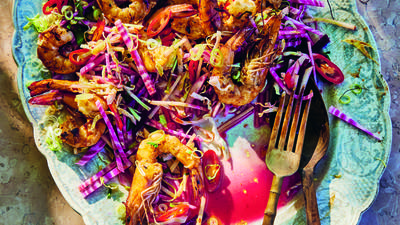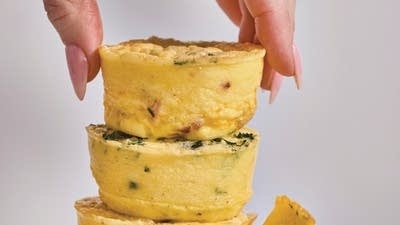
Daniel Boulud is a many-starred chef and proprietor of the New York restaurant Daniel, among many others. In this installment of The Key 3, he shares with Lynne Rossetto Kasper the techniques behind three of his favorite recipes: Le Grand Aioli, Braised Beef Shoulder and Caramelized Apple Tart.
Here are Daniel's keys, as told to Lynne:
My Key 3 are all about aspiring to entertain. And it's not only about entertaining one or two people but sometimes a family or group of friends. So I chose recipes that basically set no limit on the number of people you might cook for.
1. Le Grand Aioli
 Le Grand Aioli
Le Grand Aioli
Aioli is a delicious staple of Mediterranean cuisine and personifies the flavors and cooking style of the South of France. It has a heady taste of garlic that makes it a delicious dip or sauce for crunchy crudites or poached seafood.
It is basically a very fluffy mayo, with a pungent garlic flavor, olive oil and a little bit of spice.
You can do it by hand, but it's better to use a blender.
I use one whole egg, which I poach in boiling water -- about one quart of water with a tablespoon of white vinegar. The vinegar coagulates the egg white a little bit tighter around the yolks, so it won't spread. By poaching the egg (and adding two more yolks), I'm going to get a very silky, fluffy, light mayonnaise that is maybe a little bit more homogenous. It won't separate.
When I add my garlic, the cloves are split and the bitter green germs are removed. It's poached twice, in separate pots of water, so it's a little less pungent. It should be almost tender and a bit sweet.
Olive oil can get a little heavy on this dish, so I try to make it a little lighter by mixing in canola oil. It's about one-third olive, two-thirds canola.
While everything is blending, I always add a little tablespoon of water. It helps the emulsion of the eggs and the absorption of the oil, and it's going to make it fluffy and light.
The traditional way to serve this in Provence is with every vegetable you can find from the market -- some of them cooked, some of them raw. Then, with that, you can lay out boiled eggs, cooked mussels, steamed shrimp and poached cod. We also do a homemade crostini, about 8 inches long, which are hand-rolled with a little bit of parmesan.
Guests can put these things on their plates with a couple spoonfuls of the aioli.
Ingredients
4 large cloves garlic, peeled
1 egg
1 tablespoon white vinegar
2 egg yolks
1 tablespoon Dijon mustard
3 tablespoons water
3/4 teaspoon salt
1/2 cup extra virgin olive oil
1 1/2 cups canola oil
pinch piment d'espelette
Instructions
Cut the cloves of garlic in half lengthwise and remove the germ. Bring six halves of the garlic to a boil in cold water, then discard the water and repeat once more, cooking the garlic until tender the second time. Fill a small saucepot with a few inches of water, the white vinegar and a pinch of salt; crack the whole egg into a cup. Bring water to a simmer and slide in the whole egg. Poach for two minutes (the white will solidify but the yolk will remain runny). Transfer the poached egg into a blender or food processor and add the cooked and raw garlic, egg yolks, Dijon mustard, water, and salt. Purée until well combined. While the machine is still running, add the olive oil and then canola oil in slow steady streams. The sauce should emulsify, with a thick, pale consistency similar to mayonnaise. Taste for seasoning and then transfer into a bowl and serve with your preferred accompaniments.
Suggested accompaniments: poached cod, shrimp, crab, steamed clams or mussels, boiled fingerling potatoes, radish, fennel, cauliflower, Romanesco cauliflower, lettuces, cherry tomatoes, hard-boiled eggs, baby carrots, steamed artichokes, asparagus, wax beans, green beans, grissini, fleur de sel.
2. Braised Beef Shoulder with Red Wine and Bacon
 Braised Beef Shoulder with Red Wine and Bacon
Braised Beef Shoulder with Red Wine and Bacon
As part of my Key 3, I wanted to do a beef. I am from Lyon, close to Burgundy. In winter and fall especially, it's all about braising beef. (I have a cookbook called Braise. I love braising.) I was born and raised on a farm where we often did a very slow cook.
In France, paleron de boeuf is a staple, the kind of dish someone's grandmother would make in the winter when she needed to warm up the family.
We use a part of the beef called chicken roast, which is a muscle from the inside of the shoulder blade. It's football-shaped with a little more tip on both sides, 4 to 5 pounds, long and very lean. It's also called the chuck. It has a muscle going through it, and the gelatin of the muscle helps keep the roast quite juicy.
For the marinade, use a red wine -- a good red wine. Before I marinate any beef in red wine, I reduce the wine by half so there is a better concentration of flavor around the meat. Overnight is usually enough time, but it can marinate for 2 days.
If you are cooking for a crowd, double this recipe. (You'll need a really big pot.) There's no shame in leftovers, since it reheats so well.
Ingredients
4 pounds flatiron steak, or other cut beef chuck
2 oranges
6 cups dry red wine
1/4 cup cognac or brandy
1/4 pound country bacon, cut into 1/2 inch thick strips
2 garlic cloves, peeled and thinly sliced
Bouquet garni (4 sprigs fresh flat-parsley, 1 sprig fresh thyme, 1 sprig fresh rosemary, and 1 bay leaf tied with kitchen string)
6 stalks celery, trimmed and cut on bias into 1/2-inch-thick slices
4 large carrots, peeled, trimmed, and on the bias into 1/2-inch-thick slices
2 large onions, peeled and cut into inch-thick slices or wedges
2 cups beef stock, low sodium canned beef broth, or water
1/4 cup vegetable oil
1/4 cup (1/2 stick) unsalted butter
Coarse sea salt or kosher salt
1 1/2 teaspoons crushed black pepper
2 tablespoons all-purpose flour
Instructions
The day before you want to cook the beef, place it in a nonreactive bowl or Pyrex dish. Remove the zest of 1 orange using a vegetable peeler, including as little of the white pith as possible, and julienne. Juice both oranges and strain the juice. In a large bowl, combine the orange juice and zest, red wine, cognac, bacon, garlic, and bouquet garni. Pour the marinade over the beef, add the celery, carrots, and onions, cover, and marinate for at least12 hours, or overnight, in the refrigerator.
Place a rack in the lower third of the oven and preheat the oven to 325°F.
Transfer the beef to a platter. Strain the marinade through a colander into a medium saucepan and reserve the vegetables and herbs. Pour the beef stock into the pan and bring to a boil. Lower the heat and keep at a slow, steady simmer.
Warm the vegetable oil and butter in a large cast-iron pot or Dutch oven over medium-high heat. Pat the beef dry and season all over with salt and the pepper. Dust the beef with the flour on all sides. When the oil is hot, add the beef to the pot and sear until golden brown on all sides, 12 to 15 minutes. Pour in the hot stock mixture and add the reserved vegetables and bouquet garni.
Cover the pot and transfer it to the oven. Braise, basting and turning the beef every 30 minutes, until the meat is fork-tender, 3 to 3 1/2 hours. Discard the bouquet garni. If the sauce is too thin or is not flavored intensely enough, ladle most of it off into another pot and simmer it until it thickens and intensifies. Then add it back to the original pot and serve.
(From Daniel's 2006 book Braise).
3. Caramelized Apple Tart Lyonnaise
The last dish is from Lyon, my hometown. I went to this apprenticeship at 14, and the first thing I did was make an apple tart. It is very simple, but to me, it's the most delicious.
Find a puff pastry that is not too thick -- I would say one-eighth of an inch. When you put it between your fingers, it should be about as thick as a piece of leather.
Golden apples are basic but work very well for this tart. They're dry apples that won't get too juicy. A green apple may be a bit too tart for this.
Ingredients
All-purpose flour, for dusting
1/2 pound puff pastry, rolled into a 6-inch square, 1/2-inch thick, refrigerated until needed
1 egg yolk whisked with 1 tablespoon water
5 Rome or Golden Delicious apples, peeled, split, cored, and sliced into very thin wedges
3 tablespoons unsalted butter, softened
1 vanilla bean, split, inside scraped and scrapings mixed with 5 tablespoons sugar
Sweetened whipped cream, creme fraiche, or vanilla ice cream
Instructions
Center a rack in the oven and preheat the oven to 400°F. Dust a working surface and rolling pin with flour. Place the cold puffed pastry square in the center and evenly roll out the dough, dusting it with flour as needed. Cut into a 14-inch circle. Roll the dough around the rolling pin, then unroll onto a 13-inch round pizza pan or tart pan. Gently press the dough to line the bottom and sides of the pan, leaving a 1-inch edge overhang. Brush the edge with half of the egg yolk wash, and fold the edge under all around, pinching as you go to make a tightly fluted border. Brush the fluted border with the remaining egg yolk wash.
On top of the dough, make a ring of apple slices around the outer edge of the circle, overlapping the slices every 1/4 inch, forming a rosace (flower shape). Make a second ring of apple slices inside the outer ring. Fill the center of the ring with the remaining apples slices (you may use any broken pieces).
Carefully brush the apples with the butter and evenly sprinkle with the vanilla sugar. Bake the tart for 35 to 40 minutes or until caramelized. Reduce the oven temperature to 325°F if necessary to avoid burning. Once the crust is light brown, slide the tart from the pan onto a rack and finish baking on the rack. Cool for 15 minutes before serving.
Presentation: Transfer the caramelized apple tart to a platter and cut into wedges. Optional: Serve sweetened whipped cream, creme fraiche, or vanilla ice cream on the side.
(From Daniel's 1993 book Cooking with Daniel Boulud).

The Key 3 is a series of discussions with great cooks (not just professional chefs) about the three recipes or techniques they think everyone should know.
Before you go...
Each week, The Splendid Table brings you stories that expand your world view, inspire you to try something new, and show how food connects us all. We rely on your generous support. For as little as $5 a month, you can have a lasting impact on The Splendid Table. And, when you donate, you’ll join a community of like-minded individuals who love good food, good conversation, and kitchen companionship. Show your love for The Splendid Table with a gift today.
Thank you for your support.
Donate today for as little as $5.00 a month. Your gift only takes a few minutes and has a lasting impact on The Splendid Table and you'll be welcomed into The Splendid Table Co-op.




